Abstract
The reference diagnostic test of fibrosis, steatosis, and hepatic iron overload is liver biopsy, a clear invasive procedure. The main objective of this work was to propose HSA, or human serum albumin, as a biomarker for the assessment of fibrosis and to study non-invasive biomarkers for the assessment of steatosis and hepatic iron overload by means of an MR image acquisition protocol. It was performed on a set of eight subjects to determine fibrosis, steatosis, and hepatic iron overload with four different MRI sequences. We calibrated longitudinal relaxation times (T1 [ms]) with seven human serum albumin (HSA [%]) phantoms, and we studied the relationship between them as this protein is synthesized by the liver, and its concentration decreases in advanced fibrosis. Steatosis was calculated by means of the fat fraction (FF [%]) between fat and water liver signals in “fat-only images” (the subtraction of in-phase [IP] images and out-of-phase [OOP] images) and in “water-only images” (the addition of IP and OOP images). Liver iron concentration (LIC [µmol/g]) was obtained by the transverse relaxation time (T2* [ms]) using Gandon’s method with multiple echo times (TE) in T2-weighted IP and OOP images. The preliminary results showed that there is an inverse relationship (r = −0.9662) between the T1 relaxation times (ms) and HSA concentrations (%). Steatosis was determined with FF > 6.4% and when the liver signal was greater than the paravertebral muscles signal, and thus, the liver appeared hyperintense in fat-only images. Hepatic iron overload was detected with LIC > 36 µmol/g, and in these cases, the liver signal was smaller than the paravertebral muscles signal, and thus, the liver behaved as hypointense in IP images.
1. Introduction
Liver diseases have an annual mortality rate of 2 million people globally [1]. Liver fibrosis and steatosis are some of the most common hepatic diseases that consist of the accumulation of connective tissue and fat in the liver, respectively. These two liver diseases are related to non-alcoholic fatty liver disease (NAFLD) and alcoholic fatty liver disease (ALD), whose most common risk factors are obesity, diabetes, and alcohol consumption [2]. Both diseases can evolve to steatosis, non-alcoholic steatohepatitis (NASH) with or without liver fibrosis, cirrhosis, and end in hepatocarcinoma, which are the 11th and 16th leading causes of death in the world [1,3]. Another common liver disease is hepatic iron overload, or hemochromatosis, which is mainly genetic in origin and if it is not treated in time it can progress to other liver diseases, such as cirrhosis [4].
The early diagnosis of fibrosis, steatosis, and iron overload is key and fundamental to slow down the progression of the disease, its subsequent chronicity, and irreversibility because these three asymptomatic diseases are often diagnosed accidentally or in advanced stages of the disease [5].
Liver biopsy is the gold standard in diagnostic and prognosis. It is characterized mainly by its invasiveness through percutaneous extraction of a small sample of the liver that usually causes complications and adverse effects in the patient [6]. In addition, the study of the sample by pathological anatomy has sampling errors, inter- and intra-observer variability, and it does not provide information about the distribution of the disease in the liver [7].
On the other hand, non-invasive diagnostic tests are mainly based on different medical imaging modalities, such as computed tomography (CT) [8], abdominal ultrasound [9,10], magnetic resonance imaging (MRI) [11,12,13], and ultrasound and magnetic resonance elastography [14,15,16]. The cutting edge of non-invasive diagnosis of these liver diseases is focused on multiparametric ultrasound for the assessment of liver structure, fibrosis, steatosis, and viscoelastic properties in patients with NAFLD [17,18], as well as the use of two-dimensional shear wave elastography and attenuation imaging for the accurate assessment of fibrosis and steatosis in patients with suspected NASH [19].
The research line, called by some authors the virtual biopsy [20], is focused on quantitative diagnosis using non-invasive biomarkers on MRI. There exist many methods for dealing with the assessment of steatosis and hepatic iron overload, but few studies have focused on liver fibrosis on MRI. For this reason, the aim of this work was to study the biomarkers and the regions of interest (ROIs) for the assessment of fibrosis, steatosis, and hepatic iron overload by means of MR image analysis. We examined some previous work for steatosis and hepatic iron overload in 1.5T and 3T and proposed the protein human serum albumin (HSA) as a possible biomarker of fibrosis on an MRI protocol.
2. Materials and Methods
2.1. Phantoms
MRI phantoms were used for the calibration of the MRI relaxation times of the MRI scanner at 3T. There were 7 phantoms prepared using HSA (20% solution in 100 mL) and physiological serum at room temperature. Each phantom had a volume of 30 mL and a concentration of HSA ranged from 0 to 20%. Figure 1 shows the phantoms and their concentrations.
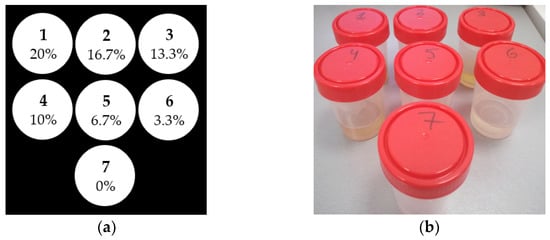
Figure 1.
Scheme with the HSA concentrations (a) and photography of the 7 phantoms (b).
One of the reasons for selecting the HSA protein is because the MRI relaxation time of this protein is similar to the MRI relaxation times of the human tissue [21].
2.2. Subjects and Image Acquisition
The MRI acquisition protocol was applied to 8 patients (7 male and 1 female —patient #8—) with an age of 45 ± 15.2 years old (mean ± standard deviation). Table 1 presents 2 patients for the study of fibrosis (patient #1 * and #2; 41 years old for both patients), 6 patients for steatosis (patient #3 **, #4, #5, #6, #7 and #8; 46.3 ± 17.4 years old), and 5 patients for hepatic iron overload (patient #3 **, #4, #5, #6 and #7; 50.8 ± 15.5 years old).

Table 1.
Patient sample data for fibrosis, steatosis and hepatic iron overload.
The MRI sequences were performed on a 3T MAGNETOM Vida MRI scanner (Siemens, Erlangen, Germany) and 1.5T MRI scanner (Siemens, Erlangen, Germany). The MRI sequences for fibrosis were B1Map_for_T1mapping and T1_Images_B1corr, which is a reconstruction of the magnetic field heterogeneity of the first sequence B1Map_for_T1mapping [22], for steatosis was T1_VIBE_Dixon and for hepatic iron overload was T2_Multi-echo. The different MRI sequences and their parameters are described in Table 2.

Table 2.
Sequence data for the assessment of fibrosis, steatosis and hepatic iron overload at 3T.
The coils required for the MRI protocol were: the radiofrequency (RF) coil of the MRI scanner tunnel (Body) which was the transmission antenna for all the sequences and the reception antenna only for the hepatic iron overload sequence, and the anterior (Body_30) and posterior (Spine_32_RS) surface RF coils, which were the reception antennas for fibrosis and steatosis sequences.
2.3. Software
The software tool used to select the different ROIs for fibrosis and steatosis was RadiAnt DICOM Viewer (Medixant, Poznan, Poland) and for the quantification of hepatic iron overload was MRQuantif (Prof. Yves Gandon, University of Rennes, Rennes, France), which is available at https://imagemed.univ-rennes1.fr/en (accessed on 12 May 2021). Moreover, Matlab R2019b (The MathWorks, Inc., Natick, MA, USA) was used for graphic representations.
2.4. Regions of Interest
The different parameters, such as the values of the relaxation times or the signal intensities, were measured with several ROIs with elliptical shape. We selected 3 ROIs for the liver in the Couinaud’s segments (IV, VIII, and VII) [23], 2 ROIs for the right and left paravertebral muscles, 1 ROI for the spleen, 1 ROI for the abdominal fat, and 1 ROI for the background noise. All ROIs have to be drawn avoiding liver vessels or artifacts that modify the measures.
2.5. Biomarkers
2.5.1. Fibrosis
Liver fibrosis consists of the accumulation of proteins in the extracellular matrix, which is synthesized by Ito cells, known as hepatic lipocytes, which produce the replacement of liver tissue by scar tissue [24]. Previous studies of liver and cardiac fibrosis demonstrated the relationship between the collagen protein concentrations and myocardial T1 maps on MRI [20,25].
In the case of liver fibrosis, the target protein was HSA, which is synthesized exclusively by the liver. Some studies showed the importance of this protein as a significant predictor that decreases its production and concentration (60–80%) in cases of advanced fibrosis [26]. For this reason, the purpose of studying this biomarker was to know the relationship between HSA concentrations (%) and liver T1 values (ms).
2.5.2. Steatosis
Steatosis consists of the accumulation of lipids, commonly triglycerides, in the liver when it exceeds 6% of fat in hepatocytes [3,27]. Therefore, the Dixon method was used for the calculation of the fat fraction (FF), as the precession frequency of the water (W) protons is greater than the precession frequency of the fat (F) protons [28].
The transverse magnetization vectors () of W and F protons with the excitation pulse are in phase but, as they have different precession frequencies, after that pulse, these vectors are out of phase until they reach the opposite phase. Therefore, it is possible to obtain in-phase (IP) and out-of-phase (OOP) images as the addition and subtraction of the signals from the protons of water and fat. In addition, fat-only images and water-only images are obtained as the subtraction and addition of the IP and OOP images respectively.
The FF (%) was calculated by Equation (1) with the fat signal (SF) and water signal (SW) of the liver in the fat-only and water-only images respectively [29].
FF (%) = (SF/SF + SW) × 100
There are different grades of steatosis depending on the gravity of the disease [27]: no steatosis (<5% of hepatocytes affected), mild steatosis (5–33% of hepatocytes affected), moderate steatosis (33–66% of hepatocytes affected), and severe steatosis (>66% of hepatocytes affected). The reference values for FF (%), based on Tang et al. [27], are: FF < 6.4% (no steatosis), FF: 6.4–17.4% (mild steatosis), FF: 17.4–22.1% (moderate steatosis), and FF > 22.1% (severe steatosis).
The Signal-to-Intensity-Ratio (SIR) was another method used to study the ratio between the liver signal (SLiver) and the paravertebral muscles signal (SParavertebral muscles), which is the reference signal, as it does not change in patients with steatosis.
SIR = SLiver/SParavertebral muscles
2.5.3. Hepatic Iron Overload
Hepatic iron overload occurs when there is an excess of accumulated iron in the liver that the human system cannot excrete [4]. The iron ions are paramagnetic substances that decrease the T2* signal and allow the diagnosis of hepatic iron overload with precision [30].
The calculation of T2* (ms) was obtained by the exponential model of the transverse relaxation component of the SLiver as a function of TE (ms) according to Equation (3) [31].
SLiver (TE) = SLiver (0) · exp (−TE/T2*) + Noise
The study of Gandon et al. [32] established a relationship between the results of liver biopsy and the results of 1.5T MRI scanner in a patient sample. In addition, it is possible to calculate liver iron concentration (LIC) at 3T with Equation (4), as T2* is approximately half at 3T than at 1.5T [32]:
LIC (µmol/g) = 0.314 · R2 * − 0.96 with R2 * = 1000/T2*
There are different grades of hepatic iron overload depending on the concentration of iron in the liver (in µmol/g dry weight). The reference values for the different LICs based on Gandon’s method are [32]: <36 µmol/g (absence of iron overload), 36–80 µmol/g (mild iron overload), and >80 (severe iron overload).
The SIR method in hepatic iron overload [33] was used to compare SLiver with SParavertebral muscles (Equation (2)), as they do not store iron.
3. Results
3.1. Phantoms
The distribution of the HSA concentrations of the 7 phantoms, and the T1 map of these phantoms, are shown in Figure 2a,b, respectively. From the result, it is clear that the T1 values increase as the HSA concentration of the phantoms decreases.
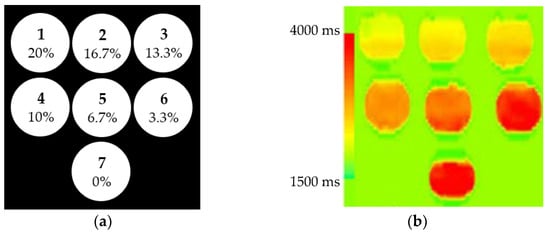
Figure 2.
HSA concentrations of the 7 phantoms implemented in this work (a) and their T1 map at 3T (b).
Figure 3 depicts the graphical representation of the T1 values (ms) as a function of the different HSA concentrations (%). A linear trend line is shown with its respective equation and its coefficient of determination (R2 = 0.9346). Additionally, this data set has a Pearson correlation coefficient (r) of −0.9662.
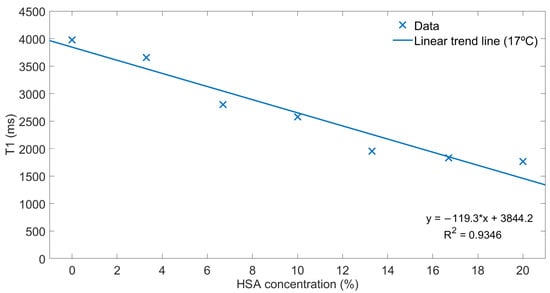
Figure 3.
Relationship between T1 values and HSA concentrations in the 7 phantoms at 3T.
3.2. Fibrosis
The presence of liver fibrosis was evaluated by comparing the T1 values from the T1 maps (ms) of a control subject (patient #1) shown in Figure 4a, with a patient with previous evidence of mild fibrosis (patient #2) shown in Figure 4b.
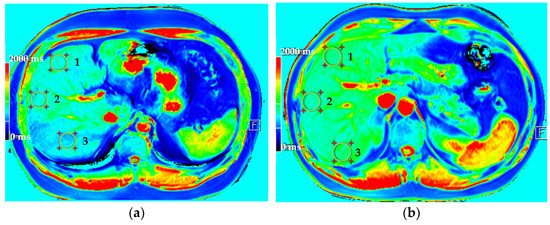
Figure 4.
T1 maps of patient #1 (a) and patient #2 (b) acquired at 3T. There are 3 ROIs in the liver following Couinaud’s segments IV (1), VIII (2) and VII (3).
T1 values for patient #1 are 750.88 ms ± 7.95 ms (mean ± standard deviation): ROI 1, 797.48 ± 66.59 ms; ROI 2, 766.20 ± 49.72 ms; ROI 3, 688.96 ± 66.6 ms. While for patient #2 they are 882.92 ms ± 3.84 ms (mean ± standard deviation): ROI 1, 889.09 ± 44.84 ms; ROI 2, 829.30 ± 50.34 ms; ROI 3, 930.37 ± 54.27 ms.
3.3. Steatosis
Fat-only images (Figure 5(a.1,b.1,c.1,d.1)) and water-only images (Figure 5 (a.2,b.2,c.2,d.2)) allow the calculation of the FF (%) (Equation (1)) at 3T and 1.5T. The results of the different grades of steatosis show the hyperintensity of the liver when the severity of the disease increases in fat-only images.
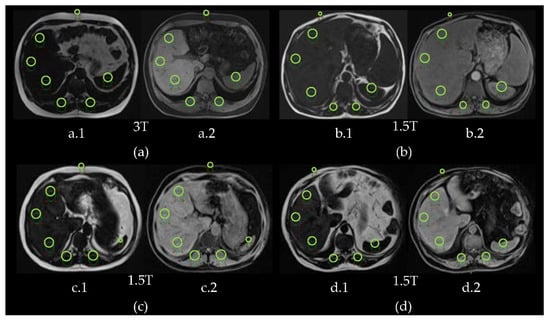
Figure 5.
Fat-only images (a.1,b.1,c.1,d.1) and water-only images (a.2,b.2,c.2,d.2) of patients #3, #4, #5 and #6. In each image there are 3 ROIs in the liver, 2 ROIs in paravertebral muscles, 1 ROI in spleen and 1 ROI in abdominal fat. (a) Patient #3 (acquired at 3T): no steatosis (FF = 3.1 ± 1.7%). (b) Patient #4 (acquired at 1.5T): mild steatosis (FF = 16.8 ± 1.6%). (c) Patient #5 (acquired at 1.5T): moderate steatosis (FF = 17.5 ± 2.4%). (d) Patient #6 (acquired at 1.5T): severe steatosis (FF = 24.8 ± 4.6%).
The signal intensity of the liver is compared with the paravertebral muscles signal intensity, which is considered as the reference signal, as it does not change significantly in the presence of steatosis. In these cases, the liver signal is greater than the paravertebral muscles signal for FF > 6.4% as it is shown in Figure 6.
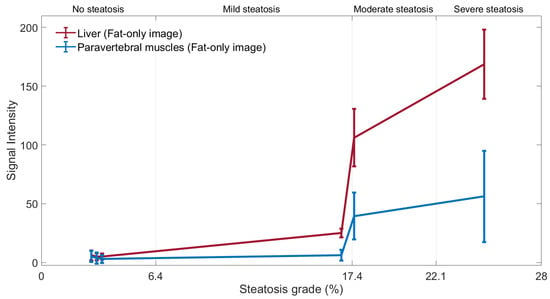
Figure 6.
Average signal intensity and standard deviation bars of the ROIs in the liver and the paravertebral muscles in fat-only images for the different grades of steatosis: no steatosis (at 3T), mild steatosis (at 1.5T), moderate steatosis (at 1.5T) and severe steatosis (at 1.5T).
3.4. Hepatic Iron Overload
Figure 7 and Figure 8 present the T2_Multi-echo sequence with 10 echoes and 12 echoes in two subjects (patients #6 and #3) with absence of iron overload, acquired at 1.5T and at 3T respectively.
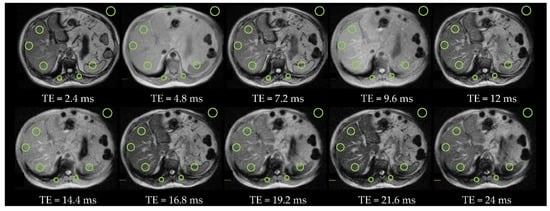
Figure 7.
Patient #6 with absence of iron overload and severe steatosis at 1.5T (T2* = 17.5 ms and LIC = 34 µmol/g). There are 10 echoes with a duration of 2.4 ms each echo. The OOP images are with TE = 2.4 ms, 7.2 ms, 12 ms, 16.8 ms, and 21.6 ms and IP images are with TE = 4.8 ms, 9.6 ms, 14.4 ms, 19.2 ms, and 24 ms. There are 3 ROis in the liver, 2 ROIs in paravertebral muscles, 1 ROI in the spleen and 1 ROI of background noise.
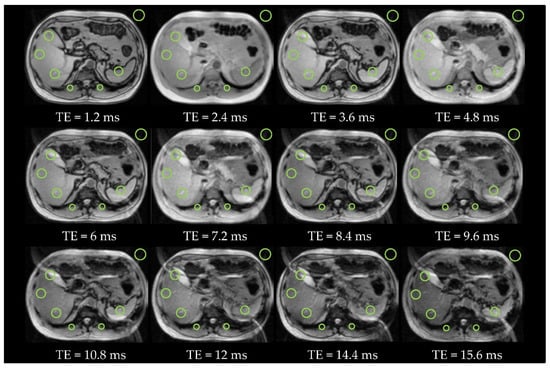
Figure 8.
Patient #3 with absence of iron overload and steatosis at 3T (T2* = 16.1 ms and LIC = 19 µmol/g). There are 12 echoes with a duration of 1.2 ms each one. The OOP images are with TE = 1.2 ms, 3.6 ms, 6 ms, 8.4 ms, 10.8 ms, and 15.6 ms and IP images are with TE = 2.4 ms, 4.8 ms, 7.2 ms, 9.6 ms, 12 ms, and 14.4 ms. There are 3 ROis in the liver, 2 ROIs in paravertebral muscles, 1 ROI in the spleen and 1 ROI of background noise.
Figure 9 shows the T2_Multi-echo sequence with 10 echoes, acquired at 1.5T, from a subject (patient #5) with severe iron overload.
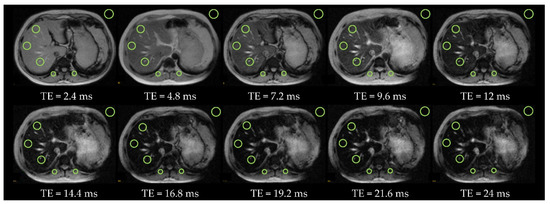
Figure 9.
Patient #5 with severe iron overload and moderate steatosis at 1.5T (T2* = 6.2 ms and LIC = 95 µmol/g). There are 10 echoes with a duration of 2.4 ms each echo. The OOP images are with TE = 2.4 ms, 7.2 ms, 12 ms, 16.8 ms, and 21.6 ms and IP images are with TE = 4.8 ms, 9.6 ms, 14.4 ms, 19.2 ms, and 24 ms. There are 3 ROIs in the liver, 2 ROIs in paravertebral muscles, and 1 ROI of background noise.
The relationship between the variation of T2* values (ms) in the liver, spleen, and paravertebral muscles, for absence of iron overload (at 3T and 1.5T) and severe iron overload (at 1.5T), is shown in Figure 10. The reference signal is the paravertebral muscles signal because it does not vary significantly when there is hepatic iron overload.
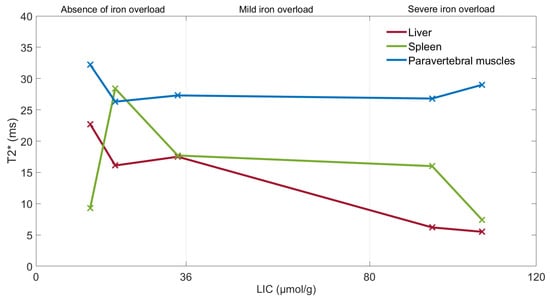
Figure 10.
Relationship between the T2* values of the liver, spleen and paravertebral muscles in absence of iron overload at 3T (13 µmol/g and 19 µmol/g) and at 1.5T (34 µmol/g) and severe iron overload at 1.5T (95 µmol/g and 107 µmol/g).
4. Discussion
4.1. Fibrosis
The calibration of the T1 relaxation times with the 7 HSA phantoms showed the inverse relationship (r = −0.9662) between T1 values and the protein concentration, i.e., the higher concentration of HSA, the lower value of T1 time. This idea of studying the relationship between the T1 relaxation time and this protein came from the relationship between the collagen concentration and T1 maps in liver and cardiac fibrosis [20,25]. Additionally, the selected protein is synthesized exclusively by the liver and some studies, such as the study by Carvalho and Machado [26], established that its accumulation decreases in advanced fibrosis.
The presence of fat and iron has to be taken into account in T1 maps as they modify the T1 relaxation times. It is expected that, in advanced fibrosis, the values of the T1 relaxation times will be higher than those obtained in this patient with previous signs of mild fibrosis. In addition, there is a need to increase the sample size and verify the results with a fibrosis reference method such as elastography.
4.2. Steatosis
The FF (%) was calculated with fat-only and water-only images which are reconstructed by post-processing IP and OOP images. For this reason, there are not differences in the calculation of the FF at 1.5T and 3T, although there is more influence in the decrease in the signal in IP images at 3T if there are steatosis and hepatic iron overload.
The SIR method is another way to assess hepatic iron overload. The results showed that the liver signal is greater than the paravertebral muscles signal when there is steatosis, and this ratio between both signals increases progressively as the grade of steatosis increases. It is also possible to compare SLiver with the spleen signal (SSpleen), but this method loses accuracy if there is iron overload in the liver, in the spleen, or in both organs. In addition, the severity of this disease can be seen through the hyperintensity of the liver in fat-only images in a qualitative manner.
The T2_Multi-echo sequence that consists of IP and OOP images can be used to assess steatosis because the signal of the liver decreases in fatty livers in OOP images. The results of the FF (%) between T2_Multi-echo and T1_VIBE_Dixon sequences did not present great differences, although the presence of hepatic iron overload affects the calculation of the FF (%) in both sequences. Therefore, the fat calculation can be omitted when there is severe iron overload.
4.3. Hepatic Iron Overload
The hepatic iron overload sequence is based on T2-weighted IP and OOP images with multiple echoes, between 10 and 12 echoes, in order to calculate the T2* transverse relaxation time with the exponential relaxation model. The IP images are more sensitive to iron because the TE of IP images is greater than the TE of OOP images and, as a result of that fact, the liver is hypointense when it has higher amounts of iron.
The duration of the echoes at 1.5T is 2.4 ms, while at 3T it is 1.2 ms because the value of T2* is approximately double at 1.5T than at 3T. Thus, the higher the magnetic field (3T), the shorter the initial TE in order to diagnose light iron overloads with greater precision, while severe iron overloads obtain better results with a lower magnetic field (1.5T). In addition, the effect of iron in the liver, and the decay of T2*, is proportional to the magnetic field [32].
Gandon’s method showed how the liver signal decreases rapidly, according to the exponential relaxation model, when the hepatic iron overload increases. Furthermore, T2* values of the liver progressively decrease below the reference signal of the paravertebral muscles as the LIC (µmol/g) increases.
The offset, or background noise, in steatosis was not relevant, but in iron overload, it can be used as a limit of the liver signal intensity. In other words, if the exponential curve of the liver is less than the background noise, T2* is overestimated, and iron overload is underestimated. Moreover, the signal-to-noise ratio is greater at 3T than at 1.5T, as can be observed in the case of absence of iron overload at 3T and 1.5T.
4.4. Limitations and Strengths
The principal limitations of this study are the small sample size of healthy and sick patients and the lack of liver biopsy as a control method. Despite these limitations, it has been possible to start a new pathway to study a non-invasive fibrosis biomarker for clinical routine. Additionally, fibrosis was evaluated when the T1 relaxation time (ms) increases, and this was displayed by means of the color scale in T1 maps, while steatosis and hepatic iron overload were evaluated with three methods: (1) Liver fat quantification with FF (%), hepatic iron overload quantification with the study of T2* (ms), and its correlation with LIC (µmol/g) using Gandon’s method. (2) The SIR method between the liver signal and the paravertebral muscles signal that increased in steatosis and decreased in hepatic iron overload. (3) Hyperintensity of the liver in fat-only images in steatosis and hypointensity of the liver in IP images in comparison with OOP images in hepatic iron overload. Furthermore, it is remarkable the influence of fat and iron in T1 values, T2* values, and signal intensities, which interfere in the reliable calculation of fibrosis, steatosis, and hepatic iron overload.
Future lines of this study should increase the size and variety of the sample of healthy and sick patients. This will allow them to study and assess the biomarker of fibrosis using the same scanner, as it was calibrated with the phantoms, compare the reference values of the different grades of steatosis in the literature and their possible difference at 1.5T and 3T, study the prevalence of steatosis with anthropometric indicators, such as BMI, abdominal fat signal, and waist index and with other parameters, such as age and gender, study other models for the calculation of T2*, and compare correlations of other authors between T2* (ms) and LIC (µmol/g).
5. Conclusions
It has been defined as an MRI protocol consisting of four sequences for the assessment of fibrosis, steatosis, and iron overload. The inverse relationship between the T1 relaxation times and the different HSA concentrations, and its application as a biomarker, showed a promising pathway for the assessment of fibrosis, especially of advanced fibrosis, that future works should investigate with a larger sample of patients and with a fibrosis reference method. The presence of fat (FF > 6.4%) and iron overload (36 µmol/g dry weight) was detected with the Dixon method and Gandon’s method, respectively, and with the relationship between the liver signal and paravertebral muscles signal, that increased in steatosis and decreased in hepatic iron overload.
Author Contributions
Conceptualization, A.M., J.M.S., A.M.M. and D.M.; Data curation, J.M.S., J.A.R. and D.M.; Formal analysis, A.M.; Funding acquisition, A.M.M. and D.M.; Investigation, A.M., R.A. and D.M.; Methodology, A.M., J.M.S., J.A.R., R.A. and D.M.; Project administration, J.M.S., R.A., A.M.M. and D.M.; Resources, J.M.S., R.A. and D.M.; Software, A.M. and J.A.R.; Supervision, J.M.S., R.A., A.M.M. and D.M.; Validation, J.A.R. and A.M.M.; Visualization, J.A.R. and D.M.; Writing—original draft, A.M. and D.M.; Writing—review & editing, A.M., J.M.S., J.A.R., R.A., A.M.M. and D.M. All authors have read and agreed to the published version of the manuscript.
Funding
This research was funded by “Conselleria d’Educació, Investigació, Cultura i Esport, Generalitat Valenciana” (grants AEST/2019/037 and AEST/2020/029), from the “Agencia Valenciana de la Innovación, Generalitat Valenciana” (ref. INNCAD00/19/085 and INNCAD/2020/84), and from the “Centro para el Desarrollo Tecnológico Industrial” (Programa Eurostars-2, actuación Interempresas Internacional), Spanish “Ministerio de Ciencia, Innovación y Universidades” (ref. CIIP-20192020).
Institutional Review Board Statement
The study was conducted according to the guidelines of the Declaration of Helsinki, and approved by the Institutional Review Board of our Institution.
Informed Consent Statement
Written informed consent has been obtained from the patients to publish this paper.
Data Availability Statement
The datasets generated and analyzed during the current study are available from the corresponding author on reasonable request.
Acknowledgments
Authors are grateful to all voluntaries for their participation in this research.
Conflicts of Interest
The authors declare no conflict of interest.
References
- Asrani, S.K.; Devarbhavi, H.; Eaton, J.; Kamath, P.S. Burden of liver diseases in the world. J. Hepatol. 2019, 70, 151–171. [Google Scholar] [CrossRef] [PubMed]
- Toshikuni, N.; Tsutsumi, M.; Arisawa, T. Clinical differences between alcoholic liver disease and nonalcoholic fatty liver disease. World J. Gastroenterol. 2014, 20, 8393–8406. [Google Scholar] [CrossRef] [PubMed]
- Vilgrain, V.; Ronot, M.; Abdel-Rehim, M.; Zappa, M.; d’Assignies, G.; Bruno, O.; Vullierme, M.-P. Hepatic steatosis: A major trap in liver imaging. Diagn. Interv. Imaging 2013, 94, 713–727. [Google Scholar] [CrossRef] [PubMed] [Green Version]
- Beaton, M.D.; Adams, P.C. The myths and realities of hemochromatosis. Can. J. Gastroenterol. 2007, 21, 101–104. [Google Scholar] [CrossRef]
- Collier, J. Clinical and biochemical assessment of symptomatic and asymptomatic liver disease. Medicine 2015, 43, 557–561. [Google Scholar] [CrossRef]
- Bravo, A.A.; Sheth, S.G.; Chopra, S. Liver biopsy. N. Engl. J. Med. 2001, 344, 495–500. [Google Scholar] [CrossRef] [PubMed]
- Pournik, O.; Alavian, S.M.; Ghalichi, L.; Seifizarei, B.; Mehrnoush, L.; Aslani, A.; Anjarani, S.; Eslami, S. Inter-observer and intra-observer agreement in pathological evaluation of non-alcoholic fatty liver disease suspected liver biopsies. Hepatitis Mon. 2014, 14, 15167. [Google Scholar] [CrossRef] [PubMed] [Green Version]
- Ros, P.R. Imaging of Diffuse and Inflammatory Liver Disease. In Diseases of the Abdomen and Pelvis 2018–2021, 1st ed.; Hodler, J., Kubik-Huch, R.A., Von Schulthess, G.K., Eds.; IDKD Springer Series; Springer: Cham, Switzerland, 2018; Volume 1, pp. 237–246. [Google Scholar]
- Dasarathy, S.; Dasarathy, J.; Khiyami, A.; Joseph, R.; Lopez, R.; McCullough, A.J. Validity of real time ultrasound in the diagnosis of hepatic steatosis: A prospective study. J. Hepatol. 2009, 51, 1061–1067. [Google Scholar] [CrossRef]
- Yeom, S.; Lee, C.; Cha, S.; Park, C. Prediction of liver cirrhosis, using diagnostic imaging tools. World J Hepatol. 2015, 7, 2069–2079. [Google Scholar] [CrossRef] [Green Version]
- Palmucci, S.; Cappello, G.; Attinà, G.; Sanzà, G.F.; Foti, P.V.; Etorre, G.C.; Milone, P. Diffusion-weighted MRI for the assessment of liver fibrosis: Principles and Applications. BioMed Res. Int. 2015, 2015, 1–7. [Google Scholar] [CrossRef] [Green Version]
- Stoopen-Rometti, M.; Encinas-Escobar, E.R.; Ramirez-Carmona, C.R.; Wolpert-Barraza, E.; Kimura-Hayama, E.; Sosa-Lozano, L.A.; Favila, R.; Kimura-Fujikami, Y.; Saavedra-Abril, J.A.; Loaeza-Del Castillo, A. Diagnosis and quantification of fibrosis, steatosis, and hepatic siderosis through multiparametric magnetic resonance imaging. Rev. Gastroenterol. Mex. 2017, 82, 32–45. [Google Scholar] [CrossRef] [PubMed]
- Qayyum, A. MR spectroscopy of the liver: Principles and clinical applications. Radiographics 2009, 29, 1653–1664. [Google Scholar] [CrossRef]
- Sasso, M.; Miette, V.; Sandrin, L.; Beaugrand, M. The controlled attenuation parameter (CAP): A novel tool for the non-invasive evaluation of steatosis using Fibroscan. Clin. Res. Hepatol. Gastroenterol. 2012, 36, 13–20. [Google Scholar] [CrossRef]
- Venkatesh, S.K.; Yin, M.; Takahashi, N.; Glockner, J.F.; Talwalkar, J.A.; Ehman, R.L. Non-invasive detection of liver fibrosis: MR imaging features vs. MR elastography. Abdom. Imaging 2015, 40, 766–775. [Google Scholar] [CrossRef] [PubMed] [Green Version]
- Domínguez, A.; Noceti, M.; Fino, D.; Ariza, P. Hepatic Elastography and Other Advanced MRI Sequences (Multiparametric MRI). Argent. J. Radiol. 2018, 82, 064–071. [Google Scholar]
- Popa, A.; Bende, F.; Sirli, R.; Popescu, A.; Bâldea, V.; Lupusoru, R.; Cotrău, R.; Fofiu, R.; Foncea, C.; Sporea, I. Quantification of Liver Fibrosis, Steatosis, and Viscosity Using Multiparametric Ultrasound in Patients with Non-Alcoholic Liver Disease: A “Real-Life” Cohort Study. Diagnostics 2021, 11, 783. [Google Scholar] [CrossRef] [PubMed]
- Sugimoto, K.; Moriyasu, F.; Oshiro, H.; Takeuchi, H.; Abe, M.; Yoshimasu, Y.; Kasai, Y.; Sakamaki, K.; Hara, T.; Itoi, T. The Role of Multiparametric US of the Liver for the Evaluation of Nonalcoholic Steatohepatitis. Radiology 2020, 296, 532–540. [Google Scholar] [CrossRef] [PubMed]
- Lee, D.H.; Cho, E.J.; Bae, J.S.; Lee, J.Y.; Yu, S.J.; Kim, H.; Lee, K.B.; Han, J.K.; Choi, B.I. Accuracy of Two-Dimensional Shear Wave Elastography and Attenuation Imaging for Evaluation of Patients with Nonalcoholic Steatohepatitis. Clin. Gastroenterol. Hepatol. 2020, 19, 797–805. [Google Scholar] [CrossRef]
- Martí-Bonmatí, L. Abdominal MR imaging and radiomics in the metabolic syndrome. An. RANM 2018, 135, 151–158. [Google Scholar] [CrossRef] [Green Version]
- Mendelson, D.A.; Heinsbergen, J.F.; Kennedy, S.D.; Szczepaniak, L.S.; Lester, C.C.; Bryant, R.G. Comparison of agarose and cross-linked protein gels as magnetic resonance imaging phantoms. Magn. Reson. Imaging 1991, 9, 975–978. [Google Scholar] [CrossRef]
- Siemens Operator Manual—Ortho. Available online: https://cbbi.udel.edu/wp-content/uploads/2017/01/Ortho.pdf (accessed on 22 March 2021).
- Sutherland, F.; Harris, J. Claude Couinaud: A passion for the liver. Arch. Surg. 2002, 137, 1305–1310. [Google Scholar] [CrossRef] [PubMed]
- Hautekeete, M.L.; Geerts, A. The hepatic stellate (Ito) cell: Its role in human liver disease. Virchows Arch. 1997, 430, 195–207. [Google Scholar] [CrossRef] [PubMed]
- Taylor, A.J.; Salerno, M.; Dharmakumar, R.; Jerosch-Herold, M. T1 mapping basic techniques and clinical applications. JAAC Cardiovasc. Imaging 2016, 9, 67–81. [Google Scholar] [CrossRef] [PubMed] [Green Version]
- Carvalho, J.R.; Machado, M.V. New insights about albumin and liver disease. Ann. Hepatol. 2018, 17, 547–560. [Google Scholar] [CrossRef]
- Tang, A.; Tan, J.; Sun, M.; Hamilton, G.; Bydder, M.; Wolfson, T.; Gamst, A.C.; Middleton, M.; Brunt, E.M.; Loomba, R.; et al. Nonalcoholic fatty liver disease: MR imaging of liver proton density fat fraction to assess hepatic steatosis. Radiology 2013, 267, 422–437. [Google Scholar] [CrossRef] [PubMed] [Green Version]
- Ma, J. Dixon techniques for water and fat imaging. J. Magn. Reson. Imaging 2008, 28, 543–558. [Google Scholar] [CrossRef]
- Reeder, S.B.; Sirlin, C.B. Quantification of liver fat with magnetic resonance imaging. Magn. Reson. Imaging Clin. N. Am. 2010, 18, 337–357. [Google Scholar] [CrossRef] [Green Version]
- Henniger, B.; Kremser, C.; Rauch, S.; Eder, R.; Zoller, H.; Finkenstedt, A.; Michaely, H.J.; Schoke, M. Evaluation of MR imaging with T1 and T2* mapping for the determination of hepatic iron overload. Eur. Radiol. 2012, 22, 2478–2486. [Google Scholar] [CrossRef]
- d’Assignies, G.; Paisant, A.; Bardou-Jacquet, E.; Boulic, A.; Bannier, E.; Lainé, F.; Ropert, M.; Morcet, J.; Saint-Jalmes, H.; Gandon, Y. Non-invasive measurement of liver iron concentration using 3-Tesla magnetic resonance imaging: Validation against biopsy. Eur. Radiol. 2018, 28, 2022–2030. [Google Scholar] [CrossRef]
- Gandon, Y.; Olivié, D.; Guyader, D.; Aubé, C.; Oberti, F.; Sebille, V.; Deugnier, Y. Non-invasive assessment of hepatic iron stores by MRI. Lancet 2004, 363, 357–362. [Google Scholar] [CrossRef]
- Alústiza, J.M.; Castiella, A.; Emparanza, J.I. Quantification of iron concentration in the liver by MRI. Insights Imaging 2012, 3, 173–180. [Google Scholar] [CrossRef] [PubMed] [Green Version]
Publisher’s Note: MDPI stays neutral with regard to jurisdictional claims in published maps and institutional affiliations. |
© 2021 by the authors. Licensee MDPI, Basel, Switzerland. This article is an open access article distributed under the terms and conditions of the Creative Commons Attribution (CC BY) license (https://creativecommons.org/licenses/by/4.0/).